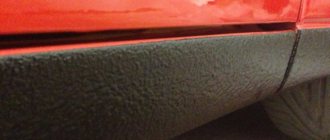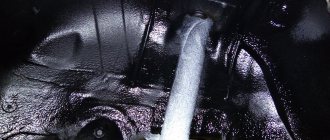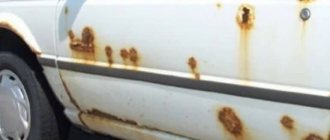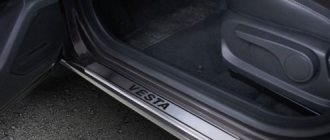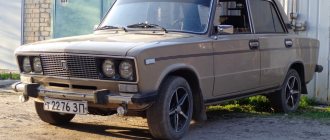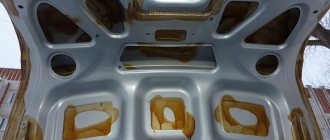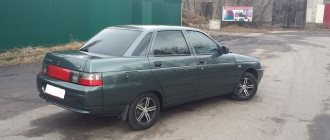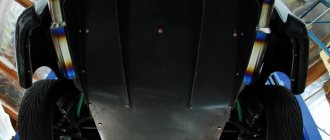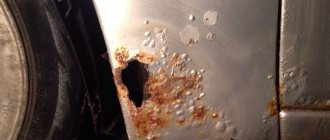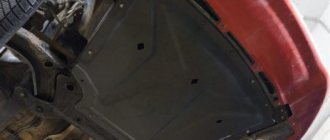Hi all! In today's article we will look at the question of how to paint thresholds with anti-gravel, the article contains many photos and is written in simple and understandable language.
It is no secret to motorists that due to salt, reagents and design features, the sills on a car are the first to begin to rust.
These days there are many options for restoring thresholds, but the simplest and cheapest option seems to be to cover the thresholds with anti-gravel. In common parlance this procedure is sometimes called “blowing out”….
What does anti-gravel coating provide?
Anti-gravel paint has several purposes:
Which anti-gravel is better
This material comes in several types:
The textured composition is better suited for application to plastic. Before purchasing, you should study the list of parts for which a particular product is suitable.
The composition is produced in 3 versions:
Preparation
To properly apply anti-gravel coating, you need to properly prepare the car. This moment, in terms of level of responsibility, is not much different from preparation, for example, for painting. For this:
How to apply
Applying anti-gravel is not difficult:
When applying anti-gravel, it is necessary to observe safety precautions; the work is carried out in a respiratory mask. It is better to carry out processing in a clean, well-ventilated area or in the fresh air.
Advantages and disadvantages
Anti-gravel treatment using spray cans, like any procedure, has pros and cons.
When purchasing, it is important to look at the expiration date of the composition. An expired product loses its quality, does not spray well, and the texture becomes uneven. A layer of anti-gravel paint not only protects the car from damage, but also does so without compromising its appearance. And the ease of use and the number of positive aspects negate the possible disadvantages of this coating.
How to treat hidden cavities
All products for hidden cavities have several important properties in common:
- penetrating ability, the compositions have special fluidity and surface tension forces;
- wettability in relation to all types of factory coatings;
- adhesion, that is, sticking to prevent oxygen and moisture from entering the protected parts;
- the ability to remain after conditional drying in a semi-rigid state so as not to crack and continue to stick to parts;
- content of corrosion inhibitors.
When choosing a specific product, you should carefully read all available ones.
The cheapest option is “Working out”
In ancient times, it was customary to close the ventilation holes and pour used transmission or engine oil into the sills. Under no circumstances should you do this now.
Oil does not protect against anything, but it perfectly promotes the peeling of existing coatings and the development of under-film corrosion, after which through holes suddenly form in the metal.
Movil and Pussalo
Movil is a product of Soviet design and has not been produced for a long time. What is now sold under this name has nothing to do with the then popular product and cannot be recommended for the protection of thresholds. The very fact of using someone else's brand says a lot.
Pussalo is a petroleum-based product, suitable for preserving metal parts, but also not suitable for thresholds. But it will be almost impossible to clean damaged cavities.
Modern anti-corrosion agents
Many formulations of varying quality are sold specifically for application into hidden cavities. You need to focus on the manufacturer’s fame and positive reviews.
The selection conditions are traditional - a reputable manufacturing company, not the lowest price, a reliable supplier and the direction of action of the product indicated in all documents and on the company’s website. Selecting a specific cylinder will not be difficult, and the protection properties are given above.
How to apply anti-gravel correctly?
Anti-gravel -
a two-component composition based on rubber and synthetic resin that protects the vehicle body. The ingredients form a seal with sound-reflecting properties, which provides less wear on the body and protection against vibration, rust, and mechanical damage.
Primary anti-gravel treatment is carried out at the factory. Thresholds, bottom, boxes and other body elements are covered with a dense layer. It forms a film that prevents premature wear of parts. Be sure to treat sills, arches, and the bottom of vehicles.
If your car doesn't already have anti-gravel protection, you should fix it immediately! To do this, you do not need to contact a car service, since you can apply the coating yourself using anti-gravel in cans, which is easy to apply and provides reliable protection of the body from rust and other damage.
What is it used for?
The purpose of the anti-gravel coating is to protect vehicle elements from the aggressive effects of external factors. Anti-gravel in the form of an aerosol is sprayed onto all body parts and, when the film dries, it performs the following functions:
Painting with anti-gravel does not require the use of professional tools, but before performing work, auto experts recommend that you read the video instructions. You should also follow simple requirements, which will be discussed below.
Types of anti-gravel
When the question arises of protecting a car from the destructive effects of external factors, you must first decide which anti-gravel product to choose? Currently, there are numerous types of protective membranes on the market, which have different bases: rubber or acrylic, as well as different compositions of additional substances. Anti-gravel for car painting differs according to the following criteria:
As for the release form, anti-gravel for a car can be:
When asked which anti-gravel agent is best, experienced car service technicians answer almost unanimously – aerosol. To apply it you do not need to have professional skills, but simply follow simple instructions.
What surfaces are anti-gravel applied to?
Anti-gravel protection is applied to various body parts. Anti-gravel on the thresholds and bottom usually has a bitumen base, so it is not recommended to paint it subsequently.
Many people are also interested in whether it is possible to apply anti-gravel coating to a putty surface. Automotive service technicians answer this question positively, and also note that the product works well on the following types of surfaces:
Many car owners note that anti-gravel coating not only has a protective effect, but also significantly facilitates car body care during operation. Dust, dirt, water stains and other contaminants are easily removed from the membrane.
Preparing the surface for coating with an anti-gravel membrane
If you decide to use anti-gravel yourself, you must first understand how to properly prepare the surface, since the adhesion and strength of the membrane will depend on this. There should be no rust on the treated surface. For cleaning, car experts recommend using the sandblasting method.
If you do not have the opportunity to use it, then wire attachments for a drill or diamond discs for an angle grinder are also suitable.
After removing the rust, thoroughly rinse the surface and dry it. Be sure to treat the welds with sealant, or use a special mixture of primer and zinc.
If anti-gravel is applied to a paint coating or acrylic primer, it is necessary to treat the surface with sanding paper for higher adhesion.
Surfaces that will not be treated must be protected using special masking tape or covering material.
How to properly apply a protective coating?
As already mentioned, car service technicians recommend using aerosols to apply the protective membrane yourself.
The LAVR company offers to order inexpensive anti-gravel aerosol in cylinders, which are characterized by excellent performance properties and an affordable cost. They are easy to use and do not require special professional skills.
Before applying anti-gravel to the sills and the bottom, it is recommended to thoroughly shake the can for 3-5 minutes. When spraying, you must adhere to the following rules:
Note:
Under no circumstances should anti-gravel coating be applied to elements of the power unit and exhaust system. Drying time is about 2 hours: after 60 minutes a dense film is formed without a sticky layer, after another equal period of time the body can be coated with paint.
Source
Applying joint sealant to seams
Before applying the sealant, use compressed air to blow dust off the treated surface. This must be done after working with Scotch Brite, especially paying attention to seams and holes.
Then take anti-silicone, apply it to a paper napkin and wipe the entire surface that has been prepared for applying anti-gravel.
It is clearly visible on the napkin that even after blowing with air, dust still remains on the surface. The napkin removes dust well and also degreases the surface.
Next, you can apply the sealant. Using a brush, pick up the sealant and carefully coat all problem areas. So, if there are pores left somewhere in the seams after welding, the sealant will fill them, and you can also use it to level out minor unevenness.
The places where the sealant was applied will be leveled when applying anti-gravel and you don’t have to worry about these fragments being noticeable.
In our case, it is clear that the sealant is very thick, since it is already leftover in the jar and it has dried out a little. In the new jar it has a thinner consistency and is easier to work with when applied.
After applying the sealant, it needs to be allowed to dry, this will take 20 to 30 minutes.
Pasting thresholds for applying anti-gravel
To protect parts, bodies not intended for anti-gravel coating are covered with film and taped along the edge of the threshold with masking tape. Next, using masking tape again, we glue it along the edge of the edging so that the anti-gravel layer lies evenly and beautifully.
Actually, here everyone can decide for themselves which part of the threshold to cover in height. Some do this up to half the threshold, others right at the door, in short, the choice is yours.
In order to end up with an even line of tape, you need to stick it with one continuous tape, stretching it along the entire contour, and not use pieces. In places where the pieces are glued, the edges may peel off and the anti-gravel will lie in an uneven line.
At the same time, it is desirable that the gun has in its design the adjustment necessary to change the supply of compressed air during operation. The adjustment allows you to change the shagreen from applying anti-gravel, for example, larger or smaller.
If the gun does not have adjustment, you can use a separate regulator; it is clearly visible in the video. It is a gearbox with a pressure gauge and an air pressure regulator knob, as well as connectors for the air supply hose and the gun.
There is a separate video on the Vlad ShchCh channel on how to make this regulator, where everything is explained in detail.
After you have connected the gun to the anti-gravel can and connected it to the air, you need to configure the gun. It is advisable to make a moderate air supply, as in the video.
Next, you can begin applying the coating. Don't forget to wear a personal protective mask so as not to breathe in the vapors of the sprayed toxic coating. We begin to apply anti-gravel from the upper parts, “going” a little onto the film coating.
It is necessary to apply several layers, with layer-by-layer drying for about 20 minutes. In hard-to-reach places, the cylinder can be turned over to get to them.
The distance from the gun to the surface to be painted is about 5-10 cm; if you take the gun further, there will be a lot of splashing and you will get a big shagreen.
Anti-gravel can be diluted, this is done using an acrylic solvent to the required consistency. To obtain the softest shagreen, the coating material is prepared more liquid.
Application of anti-gravel on thresholds
The principle of coating is identical. One has only to note that the thresholds do not have a completely smooth surface. The transition at the bottom, where it is not very convenient to pick up with a pistol, you have to adapt, reclining, propping up something for ease of work.
However, for ease of work, the car can be raised and placed on jackstands, then it will be convenient to paint the entire surface of the sills.
Several layers are also applied to the thresholds (2-3 layers) with intermediate drying. If you often travel outdoors, where the bottom of the car often comes into contact with road obstacles, then you can apply 3-4 layers. For normal urban use, applying two layers of protective coating is sufficient.
Mazda Protege (2L freedom) › Logbook › Features of applying anti-gravel
Anti-gravel coating is very effective when used inside wheel arches and on body sills. Sometimes it is applied to other parts of the body, for example, the lower parts of the doors. This is a coating that remains plastic after drying. It consists of synthetic polymer and rubber, as well as anti-corrosion additives. The anti-gravel coating is applied using a special gun connected to a source of compressed air, or with a spray can. The coating is obtained with coarse shagreen. The spray pressure should be 4–7 bar. Do not exceed the permissible pressure, otherwise the cylinder may “explode”. This is not dangerous to health, but it can cover everything around with anti-gravel composition. The shelf life of the anti-gravel composition in cylinders is not long, no more than a year. In fact, it is better for anti-gravel to be stored for no more than 6 months. It is better to check the manufacturing date of this product when purchasing as it is quite important. If the shelf life is greatly exceeded, the composition inside the cylinder turns into a difficult-to-spray mass. Heavier particles settle to the bottom and are almost impossible to mix.
What does anti-gravel coating provide?
You need to understand that different manufacturers make anti-gravel compounds of different quality and composition. High-quality modern compounds do not contain bitumen and have the following properties: • good corrosion protection • resistance to non-aggressive acids and salts • high resistance to small stone impacts • reduces noise • reduces vibrations • provides protection from machine oil, water and fuel
How to prepare a surface for applying an anti-gravel compound?
Before applying the anti-gravel coating, you need to coat the joints and welds with seam sealant. It is important to properly prepare the surface before applying the anti-gravel coating. There should be no rust left. Sandblasting is perhaps the best way to prevent corrosion, but you can also use wire attachments on a drill and grinding wheels on an angle grinder. For more details, you can read the article “removing rust from a car body.” The surface must be washed, dried thoroughly and degreased. Before spraying anti-gravel, you need to coat the welds and joints with a brush with a special joint sealant, and you can also apply primer with zinc. It is necessary to cover the adjacent surfaces using a covering material and masking tape. In case of application to a paint coating or acrylic primer, matting under anti-gravel can be done with sanding paper from p240 to p600. Surfaces that are not subject to anti-gravel application must be covered with masking tape and covering materials. In general, you need to prepare the surface as for painting.
How to apply anti-gravel coating?
Before use, you can dip the anti-gravel bottle into a bucket of hot water and leave for a few minutes. The composition will become more fluid and will mix better when shaken and sprayed. Shake the can for 3 minutes before use. The anti-gravel compound can be applied with a brush or roller, but the best option is using compressed air and a special gun. The gun must have a 4mm nozzle. Apply at a pressure of 4–7 bar. The temperature during application should be from +10 to +25. When spraying, keep at a distance of approximately 20 cm. After use, turn the can upside down and spray until clean air comes out. First, a thin layer is applied, then the remaining layers create the desired structure and film. Apply 2–3 layers. The break between layers is 2–5 minutes. After each layer you need to shake the can. The optimal thickness of the anti-gravel coating is 1 mm. Do not spray onto exhaust system or engine components. Drying time at 20 degrees Celsius: after an hour - it stops sticking, after two hours - it can be coated with paint. After complete drying, the unpainted anti-gravel coating becomes matte.
Repeating the texture of the factory coating.
You can first apply an anti-gravel composition to the cardboard and compare it with the original, factory texture. The different structure of the anti-gravel coating can be achieved by: • changing the distance to the surface • changing the pressure • changing the speed of application To avoid too coarse shagreen, you can dilute the anti-gravel composition with a thinner.
Application using an aerosol can.
Shake the can thoroughly before applying and between coats. You need to spray at a distance of 30–35 cm. This will prevent the appearance of unwanted bubbles. Considering the smaller thickness of the coating when spraying with an aerosol can, at least three layers must be applied. After completing the spraying, you need to turn the can upside down and spray until clean air comes out. This will clean the canister nozzle.
Can anti-gravel coating be painted?
If applied incorrectly, anti-gravel coating often turns out uneven and may have pores. Also, if the storage period and conditions are violated, it will be impossible to mix the composition well and it will not be sprayed correctly, leaving pores. To ensure that the surface is protected from moisture penetration, it is better to paint the applied anti-gravel coating with paint or varnish. Painting will extend the service life of the anti-gravel coating and add decorative properties. There are paintable and non-paintable anti-gravel compounds. Modern anti-gravel compounds contain synthetic polymers and do not contain bitumen, which makes it possible to paint them after drying. To ensure that the paint coating will adhere to the anti-gravel coating, the anti-gravel container must bear the inscription Overpaintable, indicating that paint can be applied over the coating. You can paint after 2 hours; in the case of water-soluble paints, you need to wait 24 hours. After painting anti-gravel, the surface is better washed during use and does not change color. One of the reasons for painting is the need to match the color with the body.
What anti-gravel compounds cannot be painted after application?
On the underbody (also used in wheel arches), a non-paintable bitumen-based anti-corrosion coating (commonly called Body Schutz) is usually used.
Is it possible to apply anti-gravel to “bare” metal?
What surfaces can anti-gravel be applied to?
Anti-gravel can be used on the following surfaces: • plastic • matte paint coating • Wash primer (primary acid primer) • putty • aluminum • steel • stainless steel • galvanized steel
What is the consumption of antigravel when spraying?
Theoretically, 1 liter is enough for 4 square meters of surface with a thickness of 1 mm. However, as a rule, the consumption is higher, and 1 liter is enough for one square meter of coverage.
Source
How to do it completely according to science?
Look at the thresholds of new cars from the assembly line - they are covered with anti-gravel and painted over it with paint in the color of the body.
How it's done?
Everything is very simple - we follow all the points from the first part of the article. After the anti-gravel has dried, we mat its surface with 600-grit sandpaper. After that, we degrease it and paint it successively with paint in the same color and fill it with acrylic varnish - all the thresholds are like they came from the factory.
I hope that after reading this article, you will understand how to paint thresholds with anti-gravel yourself.
Best regards, administrator
Why use anti-gravel coating
Anti-gravel is the general name for polymer or rubber-polymer compounds that are sprayed onto the external surfaces of the car. After application, anti-gravel creates a protective film on the thresholds with a thickness of 0.5 mm, which protects open body elements from damage by gravel, prevents reagents from reaching the metal, preventing corrosion of the thresholds.
Anti-gravel paint for car sills is a separate composition. After processing, a durable layer of protective film with a thickness of 0.1 mm remains on the surface. The paint does not ensure long-term preservation of the thresholds; the composition must be renewed every 3 months.
Causes of rust
Before you start fighting rust on the surface of your car, you should know the reasons for its appearance. Corrosion appears in those areas from which the paint that protects the metal has come off. Most often, coating failure occurs due to mechanical damage. So, while the car is moving, small pebbles fly out from under the wheels and hit the thresholds. During the impact, they knock the paint off the surface, where red spots appear. In winter, the situation is aggravated by salt, which further corrodes the damaged areas.
Types of anti-gravel for car thresholds
Requirements for anti-gravel:
All brands presented in the rating meet these requirements, but when choosing protection, you must first check the condition of the body under a layer of paint. If there are significant pockets of corrosion, then it is better to use products that contain zinc and bitumen fillers. These elements preserve the hearth and will not allow the metal to deteriorate further.
Anti-gravel coating for the body is sold in cylinders or cans. The second option requires a construction gun or spray gun. Aerosols are convenient for treating thresholds, foam well, and leave an elastic layer of protective film. Canned packaging is cheaper and is more often used for anti-gravel treatment of large surfaces.
Hi-Gear (HG5760)
Anti-gravel Hi-Gear is considered the best among aerosol compositions. Its technical characteristics are close to “liquid rubber”; it is applied with fine grain. Forms a dense film on the surface of the threshold that does not lose elasticity for up to 1.5 years. The composition is transparent, often used as an armored film to protect headlights and mirror housings.
The cost of anti-gravel in a 500 ml cylinder is from 600 rubles, the capacity is enough for the complete treatment of thresholds, it is not practical to use it on the entire body due to the high cost. The range for treating thresholds includes a black composition. Complete drying occurs in 7 days.
Body 950
Body 950 spray is developed on a rubber base for application to sills and wheel arches; there are three colors of protective coating: white, gray, black. The material foams well, leaves a lumpy surface after drying, and protects body elements for up to 2 years.
The disadvantages of anti-gravel include high cost, the need to carefully prepare the surface: degrease and sand. The product has average adhesion to smooth surfaces; it is not recommended to apply it to unprimed metal.
Liqui Moly 6109
Aerosol anti-gravel Liqui Moly 6109 is available in a single black color. It is made of polyurethane resins, has good adhesion, and provides reliable protection of thresholds for up to 2 years. After treatment, it leaves an elastic film 0.1 mm thick and is not destroyed by acids and salts.
The main advantage is the ease of further painting of the thresholds due to the maximum smoothness of the top layer. The dried surface has maximum elasticity and resistance to reagents.
Novol Gravit MS 600
One of the best anti-gravel coatings that can be applied with a gun. The technology uses synthetic materials; it is also used for processing the bottom thanks to kilogram packaging. Novol anti-gravel is produced in white, black and gray, which allows you to quickly select the color of paintwork.
The composition dries in 24 hours, forms a durable film, and has high sound insulation properties when applied to the bottom. Anti-gravel is compatible with all acrylic paints and varnishes.
Body 930
Anti-gravel mastic for thresholds and bottom, applied with a gun. Depending on the density and spray pressure, it can be applied either as fine grain or as foam. The composition contains an anti-corrosion component, which allows owners of old cars not to worry about possible missed spots of corrosion; the film reliably preserves rust.
Treatment of thresholds using protective mastics and varnishes
ATTENTION! A completely simple way to reduce fuel consumption has been found! Don't believe me? An auto mechanic with 15 years of experience also didn’t believe it until he tried it. And now he saves 35,000 rubles a year on gasoline! Read more"
During the processing process you will need such auxiliary tools and means as:
- a drill with various brushes, a metal brush or abrasive sandpapers;
- masking tape;
- converter or rust remover;
- any degreaser;
- preservative for protection against corrosion of hidden cavities of the car.
The step-by-step special processing process looks like this.
- Wash and dry the car, especially its sills.
- Provide access to all places that require treatment (if necessary, remove the outer part of the threshold, clean its internal cavity).
- The remnants of the factory anti-corrosion agent and areas with raised and peeling paint are removed. Areas with rust are cleaned especially thoroughly (preferably down to the metal). For this procedure, you can use abrasive paper, a metal brush, or a drill with brushes.
- The surface is degreased with acetone or gasoline and a rust converter or remover is applied to it.
- Any protective materials (paper, polyethylene, masking tape) cover areas that cannot be treated.
- Application of etching primer.
- Treating the surface of car thresholds with protective agents. It is possible to use aerosol bitumen and polymer-bitumen mastics, Movil, bitumen varnishes, oil-based materials with corrosion inhibitors (for example Rust Stop A), rubber-based anti-gravel (for example Motip).
- Allow the treated surface to dry completely - at least 2-4 hours.
How to prepare the surface
Work on applying film protection of paintwork is carried out at service stations, this is due to the large area of work. You can do the treatment of thresholds with anti-gravel yourself after preparatory work and selection of the necessary tools; for the work you will need:
To determine which anti-gravel is best for the thresholds of a particular car, you need to check the condition of the body. If there are significant pockets of rust, after coating with a primer it is better to choose a foam aerosol composition based on rubber resins or bitumen mastic. When damage is minimal and it is necessary to provide additional protection to the element, a synthetic composition is used, which gives a film of minimal thickness. Step by step preparation process:
Experienced craftsmen recommend applying any anti-gravel coating in two layers and not operating the car after repair for at least 10 hours.
Types of corrosion
There are two types of corrosion that can affect car sills:
- chemical – oxygen and hydrogen contained in water are natural oxidizing agents, which creates conditions for corrosion;
- electrochemical - water containing salts and gases, falling on the surface of the metal, causes an electric current, which initiates the formation of corrosion.
The metal surface can be subject to destructive effects and two types of corrosion at the same time. Therefore, it is very important to protect all elements of the car from their negative effects. Various tools and technologies that you can do yourself can help with this.
Why exactly thresholds?
Coating exterior body elements with anti-gravel and other agents with an anti-corrosion effect has long proven to be highly effective. But before you do the processing yourself, you need to clarify some points.
Thresholds are an important part of the body. They require increased protection because they are located in the lower part of the car body. Because of this, they are actively affected by various factors in the form of temperature changes, reagents on winter roads, low temperatures, intense heat, high humidity, etc. Small stones, sand, pieces of crushed stone and gravel fly from the road. They cause microdamage, destroy the paint layer, and minimize the work of factory anti-corrosion treatment.
All this leads to the fact that it is on the thresholds that the first pockets of corrosion most often appear, gradually turning into large red rust spots.
I think it’s not worth reminding once again why rust is dangerous and what consequences it can lead to.
It is important to understand that you need to fight corrosion not after it actually appears. Timely prevention and high-quality metal preservation will protect against rust and prevent it from appearing on the body of your car.
There is a huge list of products intended for anti-corrosion treatment. The choice is huge, so everyone will find an option according to their wallet and needs. Some products are priced very high, others belong to the budget category. But they are all called anti-gravel for thresholds. Most often they are produced in special cans and metal containers. Moreover, preference should be given to spray cans. Mastics require a more complex and lengthy application procedure.
But regardless of the release form of the chosen product, anti-gravel must be applied correctly, following a certain sequence. You will decide for yourself what to blow out, cover or fill with on the thresholds in your car.
Benefits of anti-gravel products
The initial anti-gravel treatment of the car body (its lower parts) is carried out at the factory during the production of the car. However, over time, this composition loses its properties, which can lead to damage to the coating of the part. Therefore, to restore the protective layer, anti-gravel is used for the body, providing protection for its paintwork and/or the materials from which its components are made (metal, plastic).
The advantages of anti-gravel treatment of a car body can be identified as follows:
- The coating formed by it (usually a polymer film) provides reliable mechanical protection that protects the treated sills, wheel arches and the bottom (optional) from the abrasive effects of sand, small pebbles, gravel and other solid particles when the car is moving. This protects their paintwork.
- Protecting the coating from penetrating moisture, which, in turn, can cause corrosion. Thus, anti-gravel is an anti-corrosion treatment for the lower part of the body.
- Protection of paintwork from exposure to ultraviolet radiation (sun rays), which causes fading, that is, loss of the original color. However, not all anti-gravel agents have this effect, but only for the most part those that can be applied directly to the paintwork (many cannot be applied to it).
- Creation of vibration and noise insulation. Anti-gravel coating of the wheel arches provides an increase in sound insulation by approximately 40% (average value, it may differ for different products).
- Protection of surfaces from exposure to oil and/or fuel, as well as other aggressive process liquids.
Some anti-gravel agents have additional benefits. For example:
- products with a shagreen effect adhere better to the surface being treated;
- with the help of some of them it is also possible to create a protective layer on plastic and/or rubber parts, thus protecting them from wear and exposure to ultraviolet radiation;
- some anti-gravity agents are excellent at displacing moisture from small internal cavities on the body (for example, from headlight cavities);
- universal products that have the function of anti-gravel and “liquid rubber” can significantly improve the aesthetic component, updating the appearance of the body paintwork.
Preparing a car for anticorrosion
Protecting a car from rust involves several stages. First of all, the car must be prepared for the process. To do this, you need to clean it from existing rust. Most often it accumulates in the bottom area, so special attention is paid to cleaning it. To do this, you should:
After this, you can treat the underbody of the car with an anti-corrosion compound.
It is usually applied in a thick layer, which takes several days to dry. It is prohibited to operate the machine during this period.
Do-it-yourself painting of car thresholds
We have reached the final stage of the work - painting. Please note: by the time of painting, the thresholds must be completely cleaned of the previous paint coating, rust, defects and irregularities must be completely eliminated with a grinding machine or sandpaper, and the surface must be treated with a primer. A layer of paint performs not only decorative functions, it is also an additional protective coating. Therefore, the choice of materials is approached scrupulously. In addition to the difference in the manufacturer and the quality of the composition, there is debate between using regular paint or anti-gravel.
Processing stages
It is important to understand that this problem can affect everyone. Yes, on expensive cars, the factory anti-corrosion treatment is of better quality and therefore lasts longer.
But when the car is in difficult conditions, constantly in contact with strong reagents, abrasives in the form of sand or gravel, even the most reliable anti-corrosive agent will not withstand it for long. Especially on the rapids. Among the most vulnerable cars are the following:
I think there is no point in listing further. It is much more important to understand the correct sequence of activities.
In total, 3 stages can be distinguished. Namely:
Actually, it is in this sequence that we will analyze the question.
Tools and materials
Please note that any anti-gravel is a very harmful composition for human health. Therefore, you should not allow it to come into contact with the skin, mucous membranes, and especially the nasal and oral cavities. You should arm yourself not only with tools and materials, but also with protective equipment.
As a result, your set should consist of:
Although you can make anticorrosive yourself, I advise you to use high-quality and proven products.
Preparing the machine
The next step is to prepare the car. You can watch the video and at the same time plan your further actions, visually learning the subtleties and nuances.
Having treated the thresholds first, I recommend that you subsequently think about protecting the body from chips and scratches in order to maximize the service life of the anti-corrosion agent.
Preparing a car involves performing the following tasks:
Preparation is of great importance for the final result of the anti-corrosion treatment. It is especially important to get rid of any existing rust and any drops of water. A hair dryer or some kind of heater, for example, will help here.
Anti-gravel treatment
And now the final stage. No less responsible and important. The complexity of application largely depends on the form of release you buy. Spray cans are more expensive, but much more convenient and effective at an excellent level.
The essence of the procedure is as follows:
In the case of mastic, you will have to spend more effort and time. This is a much dirtier method of anti-corrosion treatment, since the substance is applied with a brush. In principle, the procedure will be similar.
The thicker the layer of mastic, the more effectively the anticorrosive agent will work. Therefore, there is no need to particularly regret the remedy. After applying the first layer, be sure to wait for it to dry completely. Moreover, a hair dryer is unlikely to help in this case. Heating has the opposite effect, that is, the mastic again takes on a liquid flowing form. You can dry it simply by blowing air at room temperature.
Usually one layer of mastic dries in 2-3 hours. To apply at least 2-3 layers, you will have to spend quite a lot of time. But mastics in cans are much cheaper than cans of anti-gravel. It's up to you to choose.
Results: won’t you have to scrub off the paint?
To get the result shown above, we used:
- Two bottles of acrylic paint (450 ml);
- A couple of sheets of sanding paper (P400 and P1000);
- Solvent, dish sponge, and the protective agent itself.
Apparently, in order to remove traces of processing, you will have to apply varnish. But the varnish coating, as is known, gains strength after 2-3 days. Polishing, in turn, can only be done after the varnish has dried. Draw conclusions.
Making and applying anticorrosive coating to a car using a gun
Anti-corrosion treatment of a car is an expensive service in a car service center. Therefore, many people spend it at home. To do this, you need to know several features of the process being carried out.
Treatment of internal and hidden cavities (spars, pillars, thresholds)
Do-it-yourself treatment of hidden car body cavities is carried out using liquid materials with a low degree of viscosity containing corrosion inhibitors. To apply them, use a special air spray (can or aerosol).
These devices help treat the car's thresholds from the inside. It is recommended to proceed to protecting the remaining parts after these elements have dried.
Anticorrosive on the bottom and arches of the car
Protecting the underbody of the car from corrosion is one of the most important stages. It must be carried out on a lift, which allows full access to the bottom of the machine. At home, the lift can be replaced with an inspection hole (in extreme cases, the car is turned on its side). Anticorrosive agent is evenly applied to the bottom and arches.
Do-it-yourself anti-corrosion treatment of the underbody of a car is carried out using a roller, brush or brush. The process is carried out manually. It is necessary to treat the underbody of the car against corrosion at least 3-4 times. In this case, after applying each layer, you should wait some time until the coating dries.
Full anti-corrosive treatment of the car interior
Inside the cabin, only the floor needs to be treated, since it is most vulnerable to corrosion. To do this, remove all seats and rugs, and then begin the process. The mixture is applied with a brush or roller. If it's cold outside, you should warm up the car interior. The air temperature must be at least 15 degrees Celsius. The substance should be applied evenly, in several layers.
WHERE IS IT BETTER TO TREAT THE THRESHOLDS – AT A SERVICE SERVICE OR IN YOUR GARAGE
Most car owners know that basic anti-corrosion treatment of the car body is carried out at the manufacturer. Despite this, corrosion protection does not last forever, so it is advisable to update it every 2-3 years. Otherwise, the metal from which the body is made will begin to rust or even collapse much earlier than it should.
Timely repetition of treatment of the bottom, sills, arches and other body areas with anti-corrosion and anti-gravel significantly increases the service life of any vehicle.
Based on the above, we can conclude that anti-corrosion treatment of the body is necessary for every car owner. But where is it better to hold this event: at a service station or in your garage? Undoubtedly, specialists will do a better job than even the most “handy” master of the people. This is due to the fact that during treatment with anti-corrosion and anti-gravel at service stations they use special equipment that an ordinary car enthusiast simply cannot have. In addition, specialists are able to provide deeper and more enhanced body protection, thanks to their secret technologies and accumulated experience.
To summarize, it is important to state: the first anti-corrosion protection of the body or individual thresholds is best done at a service station. After carrying out such a procedure, you can simply update the protective layer, but on your own.
